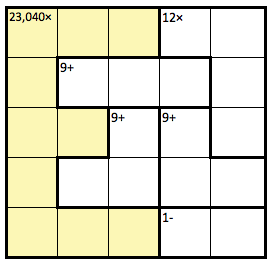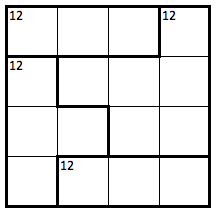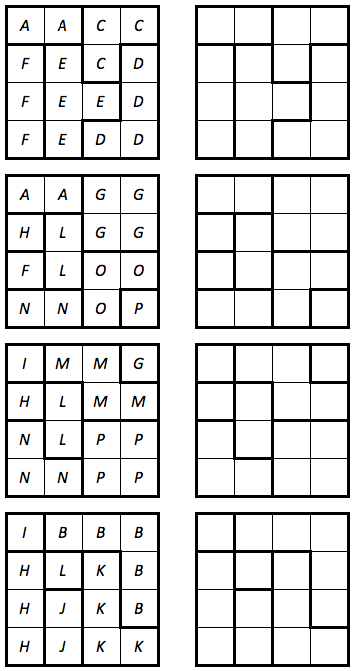AWOKK, Day 5: Harold Reiter’s Puzzles
September 23, 2016 at 5:05 am 1 comment
You’ve made it! Today is Day 5 in MJ4MF’s A Week of KenKen series. In case you missed the fun we’ve had previously…
- Day 1: Introduction
- Day 2: The KENtathlon
- Day 3: KenKen Times
- Day 4: My KenKen Puzzles
Like Thomas Snyder, Harold Reiter believes that human-generated KenKen puzzles are superior to those created by computer. But Harold pushes the envelope by developing variations on KenKen that include Primal KenKen, 3-D KenKen, n × n KenKen puzzles that use numbers other than 1‑n, and Clueless KenKen — which contain no clues and, contrary to popular belief, were not invented by Cher Horowitz. Recently, in fact, he sent me a No-Op KenKen puzzle that used the floor function.
The following standard KenKen puzzle is one of Harold’s “Big Letter” puzzles. One of the cages forms a capital E, and he made this puzzle for a friend whose name began with — wait for it — the letter E.
 No-Op KenKen Puzzles have target numbers in the cages but no operations. All the typical rules of KenKen apply, but it’ll take a little more thought to determine which operation is needed in each cage. The following is Harold’s “No-Op 12” puzzle.
No-Op KenKen Puzzles have target numbers in the cages but no operations. All the typical rules of KenKen apply, but it’ll take a little more thought to determine which operation is needed in each cage. The following is Harold’s “No-Op 12” puzzle.
 And the piece de resistance of Harold’s creations — though he says the idea for this one actually came from his daughter, Ashley — is the following 3‑D KenKen. Here are Harold’s instructions for this puzzle:
And the piece de resistance of Harold’s creations — though he says the idea for this one actually came from his daughter, Ashley — is the following 3‑D KenKen. Here are Harold’s instructions for this puzzle:
In the puzzle below, there are 48 lines. Each must contain exactly one of the digits 1, 2, 3, and 4. The 16 cages are identified by letters. Each cage is either additive or multiplicative, and the target number for every cage is 12 — meaning that the numbers in the cells of every cage either add or multiply to give 12. Ken you solve it?
This one might need a little more explanation. The four layers of the puzzle work together; for instance, the two A’s on the top layer and the two A’s on the second layer form a four-number cage with a target number of 12. Similarly, the four G’s on the second layer and the lone G in the third layer form a five-number cage with a target number of 12. All standard KenKen rules apply and are extended to three dimensions — no repeat of a digit in any row, column, or tube vector.
I prefer this presentation of the puzzle, which looks like a 3‑D tic-tac-toe board:
But Harold’s presentation of it gives you a blank version side-by-side with the original, so you have a place to record your work:
The KenKen world is indebted to Harold for creating interesting puzzles and for sharing them with a new generation of students at his local math events.
For more of Harold’s puzzles, and for suggestions on how to create your own, check out KenKen, Thinking Globally.
Entry filed under: Uncategorized. Tags: 3D, Harold Reiter, KenKen, no-op, primal, puzzle.




1. A No-Op KenKen for Today | Math Jokes 4 Mathy Folks | December 17, 2019 at 5:52 am
[…] to discern the operation for each cell. (For another example of a no-op KenKen puzzle, check out Harold Reiter’s No-Op 12 […]